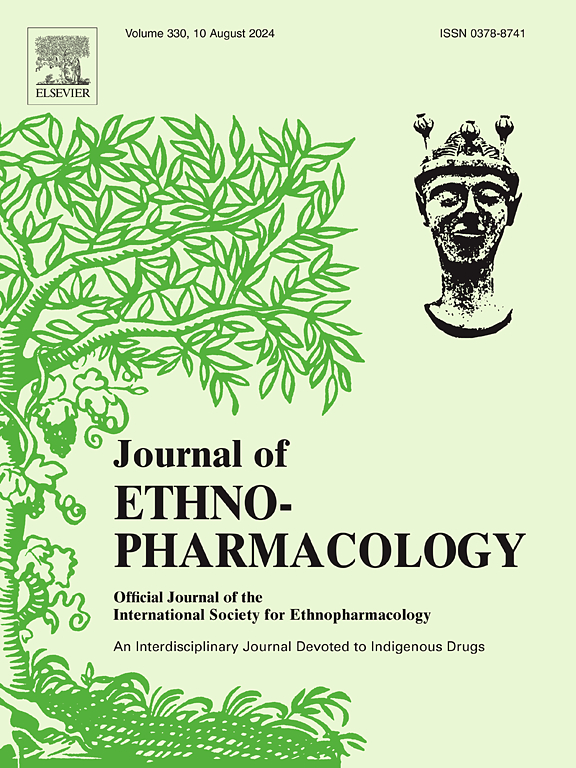Polysaccharides isolated from shufeng jiedu capsules by cross-flow ultrafiltration show anti-inflammatory effects on LPS-stimulated RAW264.7 cells and zebrafish inflammatory models
IF 4.8
2区 医学
Q1 CHEMISTRY, MEDICINAL
引用次数: 0
Abstract
Ethnopharmacological relevance
Shufeng Jiedu Capsules (SFJDC) is a traditional Chinese patent medicine comprising eight traditional Chinese medicines (TCM). SFJDC is known for its anti-inflammatory and antipyretic effects and is mainly used in clinics to treat upper respiratory tract infections. Currently, studies on the active ingredients of the SFJDC all focus on small-molecule compounds. In contrast, bio-macromolecules, such as the anti-inflammatory activities of polysaccharides in SFJDC, have not been studied, and the composition of the polysaccharides in SFJDC is also unclear.
Aim of the study
This study aimed to isolate active polysaccharides from Shufeng Jiedu capsules and determine their structural properties and anti-inflammatory activities.
Materials and methods
The polysaccharides with different molecular weights were prepared by organic solvent extraction, alcohol precipitation, dialysis, and cross-flow ultrafiltration. The structural characterization of polysaccharides was clarified by high-performance size exclusion chromatography (HPGPC), ion chromatography (IC), and Fourier transform infrared spectroscopy (FT-IR). Enzyme-linked immunosorbent assay (ELISA) and quantitative real-time PCR (qRT-PCR) assay were used to investigate the anti-inflammatory effects of polysaccharides on Lipopolysaccharides (LPS)-stimulated RAW264.7 cells. The in vivo study was employed on the CuSO4-induced and LPS-stimulated zebrafish inflammatory models, and the survival analysis, observation of neutrophil migration, hematoxylin-eosin (H&E) staining, and qRT-PCR assays were used to investigate the in vivo anti-inflammatory effect of polysaccharides.
Results
The crude polysaccharides SFJDC-CP were obtained from the mixed aqueous extract of SFJDC with a yield of 38.72 %. Both SFJDC and SFJDC-CP dose-dependently inhibited the secretion of tumor necrosis factor-α (TNF-α), interleukin-6 (IL-6), and IL-1β in LPS-stimulated RAW264.7 cells, and SFJDC-CP was more effective at a lower dosage. SFJDC-CP was further separated into three fractions, SFJDC-CP1—CP3, by cross-flow ultrafiltration apparatus with nominal molecular weight cut-offs of 100 kDa, 50 kDa, and 10 kDa membrane cassettes, and the yields were approximately 58.19 %, 10.88 %, and 30.94 %, respectively. The MWs of the SFJDC-CP and its SFJDC-CP1—CP3 were 35.7 kDa, 149.1 kDa, 34.5 kDa, and 15.1 kDa, respectively. The four polysaccharides were composed of rhamnose, arabinose, galactose, glucose, and galacturonic acid in different molar ratios. Non-toxic concentrations of the four polysaccharides ranged from 12.5 to 200 μg/mL. The four polysaccharides significantly reduced the mRNA expression levels and release of IL-1β, IL-6, and TNF-α (P < 0.0001) in LPS-stimulated RAW264.7 cells. Polysaccharides also decreased inflammatory cell infiltration and neutrophil migration (P < 0.05 or P < 0.001) in both CuSO4-induced and LPS-microinjected zebrafish inflammatory models. Additionally, they effectively inhibited the mRNA levels of IL-6 and TNF-α in LPS-infected zebrafish (P < 0.01 or P < 0.001).
Conclusions
Polysaccharides isolated from Shufeng Jiedu capsules have demonstrated anti-inflammatory effects on LPS-stimulated RAW264.7 cells and zebrafish inflammatory models. This study provided preliminary evidence that polysaccharides are one of the main anti-inflammatory ingredients of Shufeng Jiedu capsules. Additionally, it may provide valuable perspectives for investigating polysaccharides in other TCM formulations, particularly those obtained through aqueous extraction methods.

求助全文
约1分钟内获得全文
求助全文
来源期刊

Journal of ethnopharmacology
医学-全科医学与补充医学
CiteScore
10.30
自引率
5.60%
发文量
967
审稿时长
77 days
期刊介绍:
The Journal of Ethnopharmacology is dedicated to the exchange of information and understandings about people''s use of plants, fungi, animals, microorganisms and minerals and their biological and pharmacological effects based on the principles established through international conventions. Early people confronted with illness and disease, discovered a wealth of useful therapeutic agents in the plant and animal kingdoms. The empirical knowledge of these medicinal substances and their toxic potential was passed on by oral tradition and sometimes recorded in herbals and other texts on materia medica. Many valuable drugs of today (e.g., atropine, ephedrine, tubocurarine, digoxin, reserpine) came into use through the study of indigenous remedies. Chemists continue to use plant-derived drugs (e.g., morphine, taxol, physostigmine, quinidine, emetine) as prototypes in their attempts to develop more effective and less toxic medicinals.
 求助内容:
求助内容: 应助结果提醒方式:
应助结果提醒方式:


